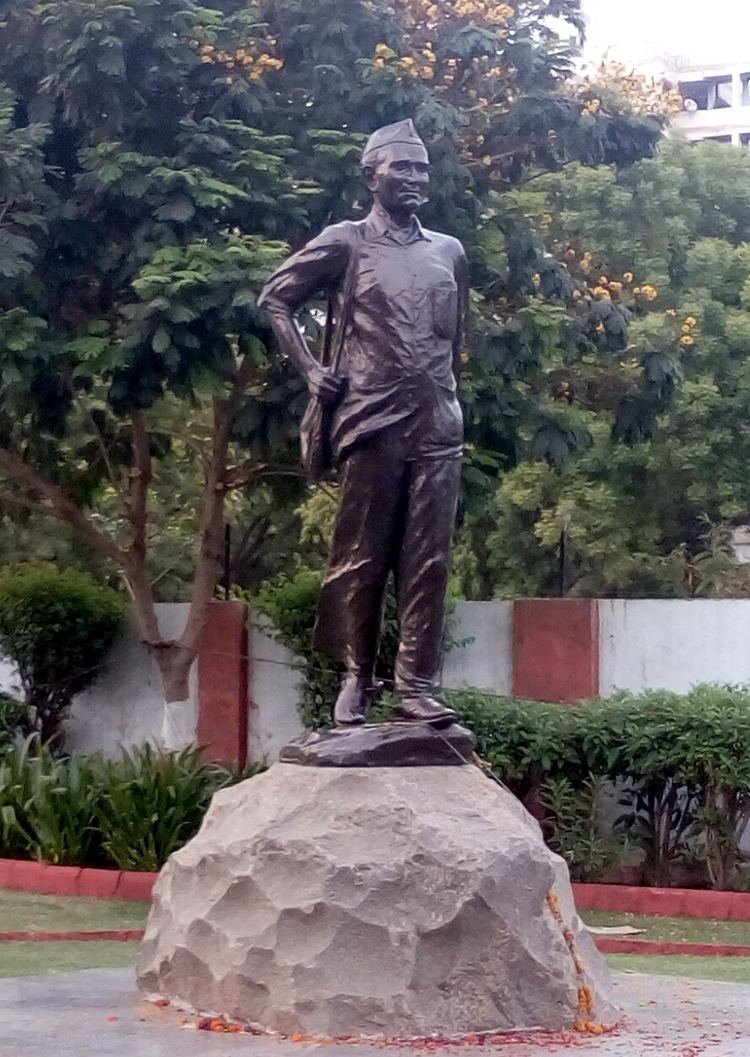Native name ઈન્દુલાલ યાજ્ઞિક Name Indulal Yagnik Other names Induchacha Role Writer | Education B.A.,LL.B. Years active 1915–1972 | |
Occupation Freedom fighter, politician, separatist, writer, editor, film maker Books Life of Ranchoddas Bhavan Lotvala Alma mater Gujarat College, Ahmedabad, St. Xavier's College-Autonomous, Mumbai | ||
Narendra modi garlands indulal yagnik s photo at gujarat assembly
Indulal Kanaiyalal Yagnik (22 February 1892 – 17 July 1972) was an Indian independence activist, a leader of the All India Kisan Sabha and one who led the Mahagujarat Movement, which spearheaded the demand for the separate statehood for Gujarat on 8 August 1956. He is also known as Indu Chacha. He was also a writer and film maker.
Contents
- Narendra modi garlands indulal yagnik s photo at gujarat assembly
- Narendra Modi speaks to media on Gujarat day after garlanding Indulal Yagniks statue
- Early life 18921915
- Independence movement 19151947
- Post independence 19471972
- Books
- Publications
- Plays
- Poetry
- Short notes
- Films
- Recognition
- References
Yagnik was elected to the 2nd Lok Sabha from Ahmedabad constituency in the erstwhile Bombay state in 1957. He was re-elected to the 3rd, 4th and 5th Lok Sabha from the same constituency from 1962–1972.

Narendra Modi speaks to media on Gujarat day after garlanding Indulal Yagnik's statue
Early life (1892–1915)
Yagnik was born at Jhagadia Pol in Nadiad, Kheda, Gujarat. His father Kanaiyalal died at a young age while studying. Yagnik completed his primary and secondary education in Nadiad and after passing the matriculation examination in 1906, he joined the Gujarat College in Ahmedabad. After passing the intermediate examination, he took admission to the St. Xavier's College, Bombay and passed his B.A. examination from there. In 1912, he passed his L.L.B. examination.
Independence movement (1915–1947)
Yagnik was deeply influenced by Annie Besant during his college days. In 1915, along with Jamnadas Dwarkadas and Shankerlal Banker, he published an English language magazine, Young India, from Bombay. In the same year, publication of the Gujarati monthly Navjivan ane Satya started. Yagnik was its editor until 1919, when he handed it over to Mahatma Gandhi. He wrote the first 30 chapters of Gandhi's autobiography in Yeravada jail after taking dictation from him.
He joined the Servants of India Society in the same year but resigned in 1917 and joined the Home Rule Movement. In 1918, he participated in the Kheda Satyagraha led by Gandhi. In 1921 he became the secretary of the Gujarat Pradesh Congress Committee. In October 1922 he started another Gujarati monthly, Yugadharm. He was imprisoned by the British from April 1923 to March 1924. From 1924–28, he was the editor of Hindustan, a Gujarati daily from Bombay. During 1926–27, he was also an assistant editor of the Bombay Chronicle. He travelled to a number of countries in Europe from 1930–35.
In 1936, he took active initiative in the formation of the All India Kisan Sabha and participated in its first session. In 1939, he founded the Gujarat Kisan Parishad. He was again imprisoned during 1940–41 for his anti-war campaign. In 1942, he presided over the annual session of the Akhil Hind Kisan Sabha. He started thea Gujarati daily Nutan Gujarat in 1943.
Post-independence (1947–1972)
In 1956, Yagnik led the Mahagujarat Movement for a separate Gujarat state and became the founder president of the Mahagujarat Janata Parishad. In 1957, he was elected to the 2nd Lok Sabha from Ahmedabad constituency as a Mahagujarat Janata Parishad candidate. After the formation of Gujarat state on 1 May 1960, Mahagujarat Janata Parishad was dissolved. In June 1960 he founded the Nutan Maha Gujarat Janata Parishad and was re-elected to the 3rd Lok Sabha as its candidate in 1962.
He died on 7 July 1972 at Ahmedabad.
Books
Publications
He started or edited several magazines including Young India, Navjivan ane Satya, and Yugadharm, and newspapers including Mumbai Samachar, Nutan Gujarat, Bombay Chronicle, and Hindustan.
Plays
Poetry
Short notes
Films
His company, Young India Pictures, produced more than ten films in Gujarati. Some of them are:
